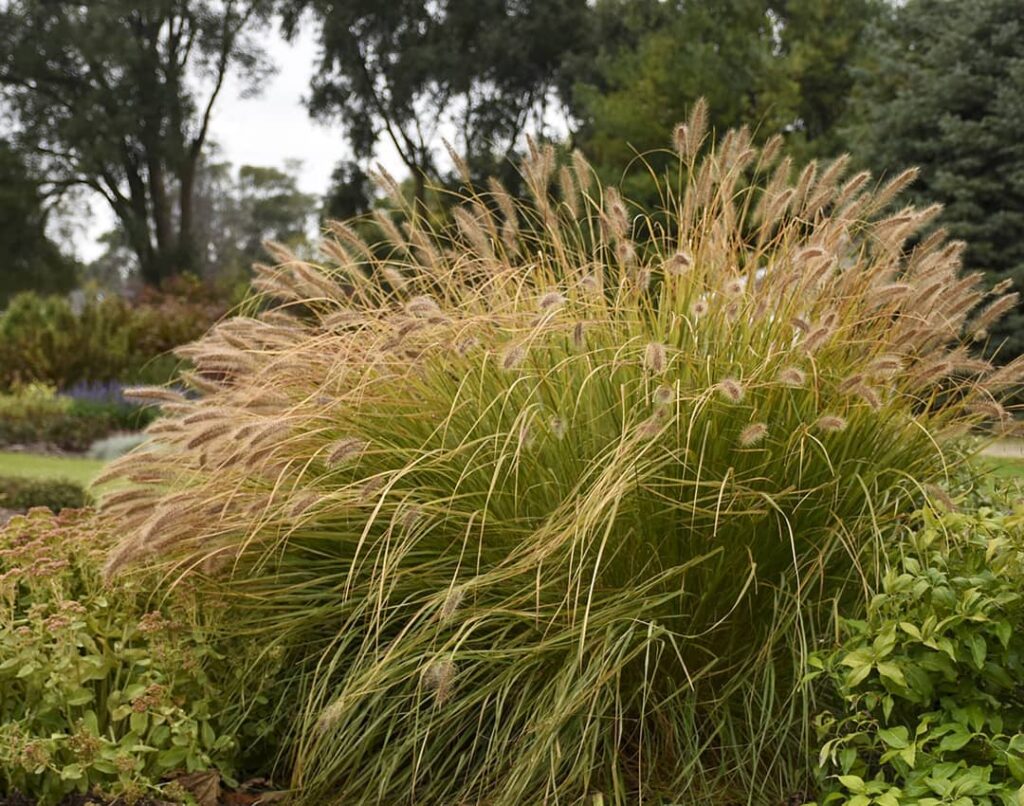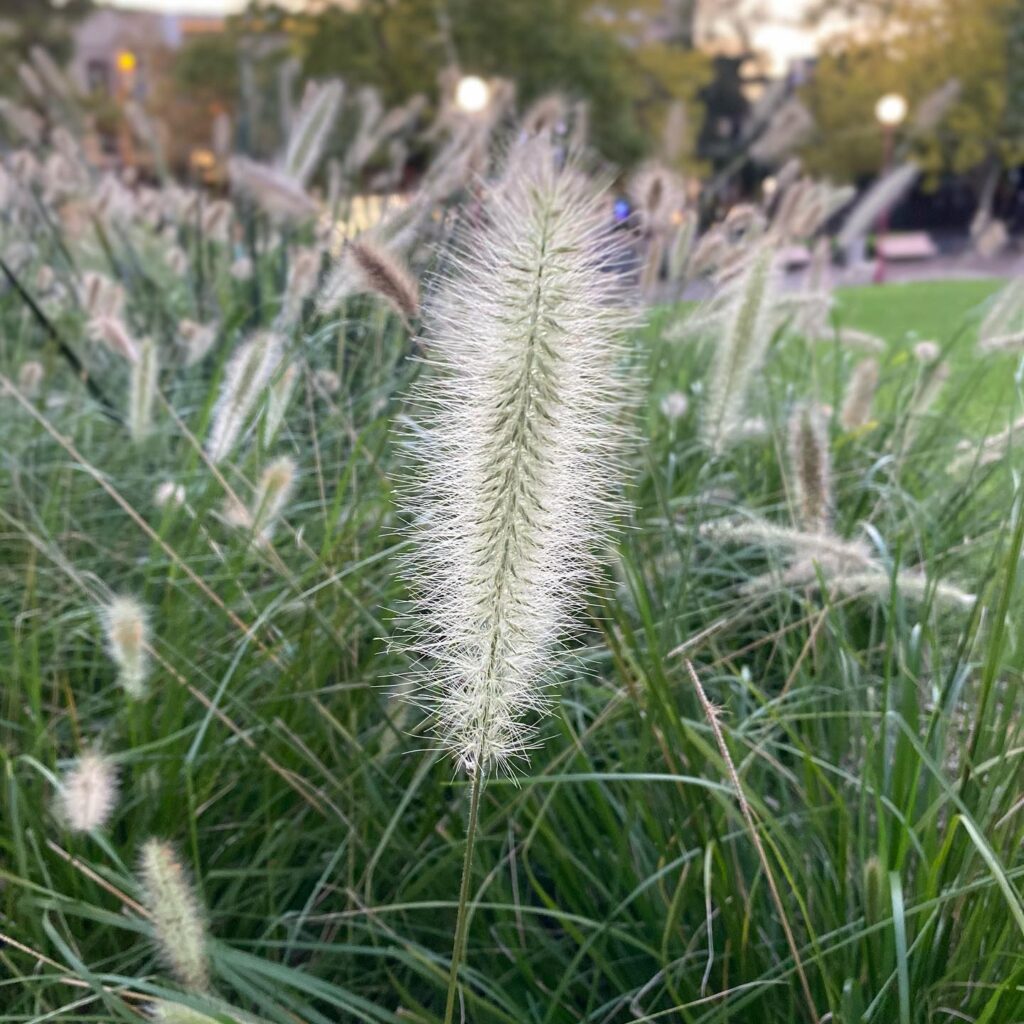Have you ever noticed how a well-trimmed bush of White Fountain Grass looks like a fluffy plant porcupine?
While fountain grass comes in many different colors, like the Red Fountain Grass variety we covered last week, we want to take a closer look at the white variety today.
If you’ve grown the Red variety before, then you’ll have no problem with this type. The care tips for both varieties are going to be pretty much the same.
By learning to take care of one type, you can take care of many!
Variety of Fountain Grass
There are hundreds of different types of grasses, but only a few kinds of fountain grass.
You’ve probably seen the topic of today’s article if you’ve ever spent time driving around Florida. You can identify the white variety by its light tan color in the summer and its pinkish brown in the fall.
Although it’s commonly called White Fountain Grass, the scientific name is Pennisetum setaceum.
People like growing this common variety of fountain grass because it blooms early and in Florida, blooms for a long time.
This species won’t grow past 6 feet tall, so they aren’t often used as privacy hedges.
Other types of fountain grass that we might have in stock at our nursery include ‘Purple Majesty,’ ‘Cassian,’ ‘Little Bunny,’ ‘Little Honey,’ and ‘Moudry.’
How to Identify White Fountain Grass
White Fountain Grass grows in a dense but graceful clump 12-60″ tall, depending on the growth factors. It grows upright at first; then, the leaves arch at maturity into the easily identifiable fountain pattern.
The length and width of the long, tapering, subtly serrated blades vary greatly among plants. The leaves turn orange-bronze in autumn, eventually fading to a dull beige.
During the winter, it’s easy to confuse it with deer grass (Muhlenbergia regens) because the flowers drop off, and there’s a less pronounced arch.
Suggest Uses This Variety
Some of our landscape designs have included using fountain grass beside sun-loving prairie perennials like coneflowers and coreopsis.
For clients that wanted a more naturalistic garden, we mingled it among tall and medium annuals.
One final suggestion would be to consider blending it into large container plantings by using the tall plumes as a high point in the rear of the pot.
Does White Fountain Grass Come Back Every Year?
This is one area where the white variety differs from the red. White fountain grass (Pennisetum alopecuroides) is actually a perennial plant and not an annual like the red variety.
Its perennial nature is why you’ll still find these kinds of grass in climates with a colder winter.
In areas without a cold winter, like Florida, this kind of fountain grass will bloom for almost the entire year.
White Fountain Grass Hardiness
Let’s go ahead and break down the hardiness of this plant in a little more detail. This perennial plant thrives in USDA Zones 6-9… which falls right in Florida’s growing zones!
Ideally, it would be grown in a medium moisture environment, with well-drained soil in full sun.
Although plants can be grown from seed, pre-grown starts plants are typically purchased from nurseries like ours to help save years of waiting.
Technically plants can be dug in fall, trimmed, and overwintered in greenhouses or indoors in sunny, cool areas, but many gardeners simply prefer to plant in the spring to avoid the hassle.
Young plants may need some staking or other support and should be sited in areas protected from strong winds.
They will need consistent water throughout the growing season to help fight the Florida heat.
How to Prepare White Fountain Grass For Winter
If you’ve planted your grass in an area without a cold winter like Florida, you don’t need to do anything to help it survive winter.
If you live in a colder climate and want to help this perennial plant through the cold, then you can trim White Fountain Grass back is in the late winter or early spring. The exact timing is not as important as just making sure that you prune fountain grass back before it comes out of dormant.
You want to avoid doing fountain grass pruning in the fall, as the plant has not yet gone fully dormant yet.
If you try to cut back fountain grass in the fall, you may cause it to go into a growth spurt, which will make it more vulnerable to the coming cold weather and will reduce its chances of surviving the winter.
Steps for Cutting Back Fountain Grass
Cutting back fountain grass couldn’t be easier! And taking the time to cut back fountain grass will result in a nicer-looking “fountain” in the summer.
Step 1
When you trim the fountain grass back is to tie up the dead stems. This is just to make the chore of cutting back fountain grass a little easier because you won’t have to clean up all the fallen stems.
Step 2
The next step in fountain grass pruning is to use a cutting tool, such as pruning shears or hedge clippers, to cut back the stem bundle. Prune your White Fountain Grass about 4 to 6 inches above the ground. The remaining stems will be quickly hidden under the new growth.
That’s all there is to it!
How Did It Get To The US?
Fountain Grass is originally from Africa. It wasn’t until 1880 that fountain grass seed was first available in the US. Decades later in 1940, it began to be cultivated as an ornamental plant in Tucson.
As the plant tends to do, it started to spread pretty quickly. Records show that fountain grass began establishing itself in the Santa Catalina Mountains north of Tucson as early as 1946.
Nowadays, fountain grass of all varieties are sold in nurseries for gardens and landscapes. The seeds are spread by wind, water, and by animals and humans.
Where to Buy White Fountain Grass?
Take advantage of these White Fountain Grass care tips by raising some plants of your own!
Visit our nursery at Troy Tropics and turn your backyard into an outdoor paradise.
Our team of greenery experts can help you decide on the best plants for your home.
Contact us through our online form or call us directly at (941) 212-1671.




